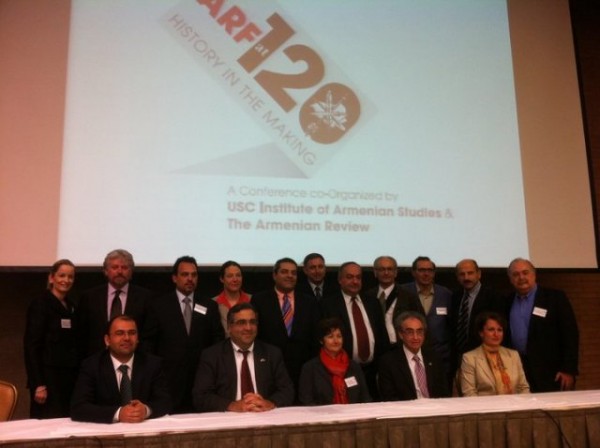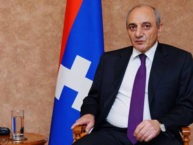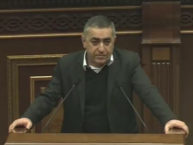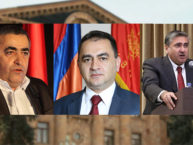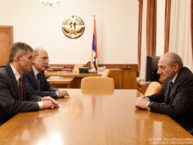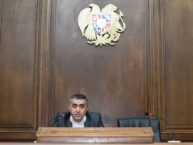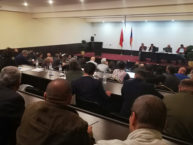LOS ANGELES – Academics, politicians and leading activists from Armenia and the Diaspora gathered at the University of California on Saturday, December 4, to explore the 120 year history of the Armenian Revolutionary Federation, one of the oldest and most influential political organizations in Armenian history.
Founded in Tbilisi, in 1890, the ARF was the brainchild of a generation of young, educated Armenians, whose patience with the complacency of their elders toward the bleak reality facing the Armenian nation had come to an end.
Speaking to an audience of more than 400 people at the USC Davidson Conference Center, ARF-Dashnaktsutyun Bureau Member Vicken Hovsepian presented a brief glimpse into the long history of the organization and the myriad of topics the conference panelists were to discuss during the day.
“During this conference, it seems we will only catch a glimpse over the past, the present and the future of an organization which through its history of some 120 years has touched upon so many facets of what we call the Armenian reality; in fact, in many instances and in many ways, I believe the ARF has indeed shaped itself through what we call the Armenian reality,” said Hovsepian.
He thanked the conference task force, Asbed Korchikian, the editor of the Armenian Review, Vatche Mankerian, the Program Manager of the Institute of Armenian Studies, and particularly, the Director of the Institute, Prof. Hrair Dekmejian, “whose scholarship and leadership have been and continue to be an inspiration to many of us.”
Panel I: ARF in History and Ideology
The symposium’s first panel, moderated by Professor Richard Hovannisian, studied the formative years of the ARF and the founding ideals of self-determination and social justice espoused by the revolutionary activists and intellectuals.
The panel opened with an intriguing look into the early years of the ARF by Professor Houri Berberian of the California State University at Long Beach. Berberian discussed her research into the transnational character of the ARF and its deep integration and involvement with political and social movements taking place across the three neighboring empires of the region.
Berberian’s presentation, titled “Connected Revolutions: The ARF & Russian, Ottoman, & Iranian Revolutions in Early Twentieth Century,” argued that ARF revolutionary and intellectual leaders saw the situation of Armenians in one empire as “directly dependent on the situation of their neighbors and their government.”
As such, she explained, the ARF was circulating “revolutionary elites, activists, and intellectuals as well as revolutionary literature and arms throughout the three regions before and during the revolutions.” Traveling from one Armenian community to another in these countries, she added, ARF activists were “closely and intimately entangled” with these revolutions, often times playing important and leading roles.”
The ARF’s involvement in each of these revolutions was largely a result of the organization’s pragmatic world-view arising from the close linkage between national liberation and socialism underpinning its ideology.
Professor Khatchig DerGougassian, of Universidad de San Andres, Buenos Aires, discussed this duality in his presentation on the historical evolution of ARF ideology. During his talk, titled “Dialectical Dynamics of Socialism & National Liberation: Historical Evolution of ARF Ideology,” DerGhougassian introduced what he described as a “novel approach” to understanding an ARF ideology that has thus far been incompletely “portrayed as a pragmatic balance of socialism and nationism.”
He argued instead that the “official ideology of the ARF has always been socialism in its reformist/non-Marxist version known as social-democracy.” But this flavor of socialism, he noted, has from the beginning been tied to the national liberation struggle, evolving to cope and adapt to the situations facing the Armenian people.
Elke Hartman of the Free University in Berlin, highlighted that point during her own discussion of the concepts and strategies of ARF self-defense policy during the first decades of the 20th century. Her paper, titled “The Turks & Kurds are our fate”: ARF Concepts & Strategies of Self-Defense,” explored the Armenian Fedaye movement in Western Armenia from the perspective of Roupen Der Minasian, a prominent fedayee who served as a minister in the First Armenian Republic and member of the ARF Bureau.
Roupen’s 7-volume “Memoirs of An Armenian Revolutionary,” Hartman said, reveal differences within the party’s approach to the immediate danger facing Armenian villagers in the provinces. These diverging perspectives, she argued, ultimately led to the adoption of a self-defense agenda that went beyond armed struggle to including a political approach as well. That political policy, she explained, manifested itself in the organization by the ARF of local judicial and administrative structures to bring order to life in the provinces for Armenians and non Armenians alike, as well as through cooperation with the Young Turk movement in an attempt to bring constitutional reform to the Ottoman Empire.
Panel II: The ARF and Society
The second panel, moderated by Professor Stephan Astourian of UC Berkeley, looked at the ARF’s role in Armenian society at large, from its early years to the present day.
The first panelist, Arsen Stepanyan, presented his research on youth and political activism in post Soviet Armenia, focusing primarily on the ARF and its youth wings in Armenia. Stepanyan, who serves as advocacy program manager of Counterpart Armenia, discussed the role of youth in Armenia’s political parties and how the ARF, within this context, perceives and relates with the demographic.
Stepanyan, whose presentaiton was titled, “The Role of Youth in Armenian Political Parties,” explained that in Armenia, youth are concerned primarily with housing, employment, education, and communication–social issues that, he said, would logically motivate youth to engage in politics and civil society. But the political parties rarely address those issues beyond the surface, he noted, adding that the institutions where engagement is natural–the schools, universities, and in political parties–fail to facilitate meaningful participation.
His analysis then honed in on the ARF’s own interaction with youth, discussing some challenges the organization faces in engaging them and presenting recommendations to improve its recruitment and mobilization of its this vital constituency.
Following Stepanyan’s examination of ARF-youth relations, Maria Titizian, the director of the Hrayr Maroukhian Foundation in Armenia, explored the role of women in the ARF throughout its 120-year history in a presentation titled, “Women in the ARF: Past, Present & Future.”
Titizian, who is a Vice President of the Socialist International and serves as the ARF’s representative to the Socialist International Women, focused her presentation on three distinct time periods: the National Liberation Movement of the 1880s-1921; the exile from Soviet Armenia and the formation of Diasporan communities from 1921-1991; and the re-emergence of the party in Armenia after independence in 1991. Titizian also paid particular attention to the role played by ARF women in the creation of the ARF, the government of the First Armenian Republic, and the Karabakh liberation struggle.
Her presentation revealed a general absence of women in key decision-making bodies of the ARF, which she explained was a reflection of an Armenian reality in which men dominate in social and political life. Titizian underscored that gender inequality has “served as an impediment to democratization and development in the Republic of Armenia and to the deficiency of women’s perspectives, views, and experiences in the Diaspora.”
In concluding her presentation, she charted a course forward for the ARF, urging the party to lead the way to change by ensuring “the creation of a level playing field that will remove the subtle barriers to the advancement of women within its party structures.”
Professor Ara Khanjian of Ventura College followed Titizian’s presentation with a detailed report of the ARF’s economic policy for Armenia and its opposition to the neo-liberal approach of the ruling regime. His discussion covered a gamut of socio-economic problems plaguing Armenian society, from widespread poverty, to the unequal distribution of wealth and income, to the country’s uneven development.
Khanjian recalled the ARF’s opposition to a series of crippling economic measures adopted by the government earlier this year. His paper, titled “Pension Reform, Income Taxes & Open Borders: Conflicting Perceptions of Armenian Government & ARF,” argued that Armenia’s socio-economic crisis as one caused by the failed neo-liberal policies of a ruling regime increasingly intent on diminishing the role of the state in the economy and society. In that regard, he presented the ARF’s criticism of Armenia’s unfair income tax law, which applies nearly identical tax rates to both rich and poor; to an extreme private pension system that hinges retirement to the market; and to the opening of the border with Turkey without protections and subsidies for domestic production.
Moving from homeland to Diaspora, Professor Levon Chorbajian presented a content analysis of “ARF Media & its Coverage of the Protocols.” A professor of Sociology at the University of Massachusetts, Lowell, Chorbajian examined the ARF’s opposition to the Armenia-Turkey protocols by looking at the organization’s media in the United States.
In his presentation, Chorbajian discussed the varying degrees of coverage the protocols received in ARF media, from opinion and editorial pieces opposing the diplomatic deal, to social and political analyses of the consequences, to coverage of campaigns and demonstrations against the agreement. His paper revealed that the “serious shortcomings” of the Protocols “led almost immediately to opposition both in Armenia and in the diaspora, and the leading, if not the sole, voice in this opposition was the ARF.”
Professor Viken Yacoubian of Woodbury University continued the discourse on the ARF’s role in Diasporan Armenian society with an in-depth exploration of its impact in shaping Armenian identity in the diaspora. Yacoubian’s presentation, titled “The Role of the ARF in the Ethno-racial Identity Development of Armenians in Diaspora,” explored the “unique diasporic experience of Armenians and its impact on their ethno-racial identity formation,” through the prism of existing research on ethnic and racial identity development of minorities.
His analysis focused on the contributions to this identity by the complex community infrastructures developed by the ARF throughout the global diaspora and the nature of the “sociopolitical milieu” which it has helped create.
Panel III: ARF Between Nation and State
The third panel, moderated by Khatchig Tölölyan of Wesleyan University, examined the ARF’s activities over the last few decades, both in Armenia and the Diaspora, within the framework of nation and state.
Aram Hamparian, the Executive Director of the Armenian National Committee of America, kicked off the discussion with an inspirational account of ARF political advocacy in the United States, tracing the evolution of the Armenian American community’s advocacy agenda over the past 120 years, chronicling that development in four stages: “The Politics of Pity” at the turn of the century; “The Politics of Protest” against Genocide denial in the 1950s and 1960s; “The Politics of Pressure” in the halls of Congress during from the 1970s-1990s; and “The Politics of Civic Integration” today.
“America is the place where asserting your rights brings rewards, not the silence of the Ottoman era,” Hamparian said. “We must participate, integrate & assert our rights.”
Hamparian’s talk, titled “The Anatomy of Advocacy: The ARF in North America,” ultimately focused on the challenges faced and overcome by the Armenian-American community over the course of many generations. Through this prism, he discussed tactics employed by the ARF and ANCA to generate grassroots and other forms of political and policy-based leverage aimed at impacting U.S. foreign policy on issues of concern to the community, such as the recognition of the Armenian Genocide, support for the Republic of Armenia, and recognition of the Nagorno-Karabakh Republic’s Independence.
After Hamparian, Armen Sargsyan, a member of the National Assembly of the Mountainous Karabakh Republic, took the discussion to Artsakh and the ARF’s role in establishing its statehood. In his detailed presentation, titled “The ARF in Mountainous Karabakh,” traced the party’s involvement in the mountainous territory from the early 1900s to the present day.
Sargsyan presented a brief overview of Karabakh’s political history, trailing the ARF-Dashnaktautyun’s efforts to liberate and integrate the territory into the first Armenian Republic between 1918-1920 and again in 1989 as the Soviet Union was crumbling.
He explained that the ARF had, since its establishment in 1890, sought to build its structure in Artsakh and had done so by 1918. The joint Russian and Soviet invasion of Armenia at the end of 1920, however, forced the party into exile and led to 70 years of Azerbaijani occupation of the land. The ARF relocated back to Artsakh in 1989 and became the most organized political force during the national liberation movement, fighting in the battlefield, organizing the government, and supporting the movement from the Diaspora, he explained.
Sargsyan concluded that, today, the ARF has a monumental responsibility to fill in Artsakh. “Nothing is more paramount than the task of channeling the efforts, the potentials, professionalism and resources of the Diaspora to help in Artsakh’s developmental process,” he stressed, adding that the final goal is to ensure Artsakh’s political recognition internationally.
The next panelist, Professor Ohannes Geukjian, from the American University in Beirut, moved the discussion to the ARF’s role in Lebanon, examining the policy of the ARF in Lebanon from the early 1970s until 1989.
In his presentation, titled “The ARF in Diaspora: The Taif Accord & Armenians of Lebanon (1972-1991),” Geukjian presented an analysis of reform plans the ARF initiated and presented to the Lebanese warring parties to end the Civil War.
According to Geukjian’s research, the ARF along with the Hunchag and Ramgavar parties ultimately adopted a policy that “promoted dialogue rather than violence to resolve all the disputed issues, peaceful coexistence between the communities and social justice and democracy as a means to build the future Lebanon.”
The final panelist, Professor Asbed Kotchikian of Bently University, examined the early years of Armenia’s independence and how the ARF attempted to become a political party operating in the country while keeping its traditional structure in the Diaspora as a communal and advocacy group.
According to Kotchikian, who serves as the editor of the Armenian Review, Armenian political groups operating in the Diaspora have tried and largely failed to become politically active in Armenia, both on the ground and in the National Assembly. Contrary to the norm, he explained, the ARF has consistently managed to achieve a certain level of support from the Armenian electorate. Noting that this support has stayed relatively low, however, Kotchikian asked whether the party had, in fact, managed to transform itself into a true political party in Armenia, or was it still a “captive of diasporic politics.”
In addressing that central question, Kotchikian suggested that the ARF, and the other traditional political parties of the Diaspora, were unprepared for independence. He argued that four key factors have created challenges for the ARF’s political development in Armenia.
The challenges, he asserted began with the diverging priorities in Armenia and Diaspora and continue to increase as the dichotomy between being a loyal opposition or a disobedient ally began to play out for the ARF. He also noted the ARF’s change from above approach and its under-investment in civil society structures as key factors preventing the party from making significant impact on the way politics is conducted in Armenia?
Understanding the Past to Forge the Future
In remarks delivered at the beginning of the conference, ARF-D Bureau member Viken Hovsepian had spoken of the ARF’s long history in the Armenian reality, highlighting its “presence in over 30 countries, over 150 cities, with its members in 5 different parliaments.” The fact that its global membership is “engaged in advocacy & lobbying efforts on behalf of Armenian interests in many capitals of the world and across many issue areas speaks of the Organization’s coverage, and also of its leverage,” said Hovsepian.
“The fact that the ARF has played an instrumental role in more than one non-Armenian revolution, led efforts of Armenian liberation; the fact that it’s led the civil defense of a few Diasporan communities, it’s led a Republic, vehemently opposed another, and last but not least, helped shape Diasporan Armenian communities as we have them today, speak of its unique role in Armenian history and the breadth of its agenda,” he said.
Hovsepian acknowledged that the conference was not a complete examination or analysis of ARF history, explaining that an in-depth examination would be “simply inconceivable” with the limitations of a single conference. “Looking over the conference agenda, there really is so much more that could have or should have been covered, had time allowed,” he said. “And yet, we deem this conference to be a first, an impressive start, and a start that we welcome.”
The ARF Bureau member expressed hope that the examination, analyses, and discussions of the conference would “not only promote a better understanding of the past and the present, but will allow a greater appreciation of what the future prospectively holds for the ARF, its work, and ultimately for the nation in whose interest this organization was founded and whose service this organization is engaged in.”

